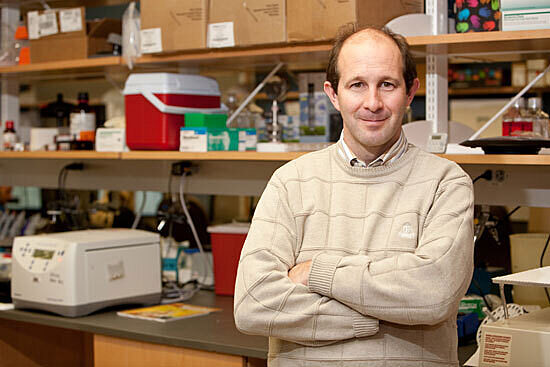‘Friendly fire’ may be at the root of Parkinson-like diseases

Todd Golde, M.D., Ph.D., director of the UF College of Medicine’s Center for Translational Research in Neurodegenerative Disease (Photo by Jesse Jones/University of Florida)
Scientists have suspected exposure to viruses and other environmental factors may trigger symptoms associated with Parkinson-like diseases, but why such exposure would actually destroy certain areas of the brain has been mysterious.
New research suggests a pathway located at the base of the brain that is essential for the execution of smooth, coordinated movements may be selectively damaged by the friendly fire of the body’s immune response, according to University of Florida and Mayo Clinic Florida scientists writing today in Nature Neuroscience.
“In the movie ‘Awakenings,’ it was suggested that people who previously suffered from an infection like the flu developed Parkinsonism, probably because of degeneration in a brain pathway known as the nigrostriatal tract. But the links between infection and subsequent Parkinsonism have always been controversial,” said Todd Golde, M.D., Ph.D., director of the UF College of Medicine’s Center for Translational Research in Neurodegenerative Disease. “Our data show that when a certain master protein that stimulates the immune system and antiviral response is expressed at high levels, it causes neuronal loss primarily in the nigrostriatal tract, thereby creating vulnerability to Parkinson’s and similar movement disorders.”
The most well-known Parkinsonism — Parkinson’s disease — affects more than 1 million Americans, causing patients to gradually develop movement problems, such as tremors, stiffness and slowness.
The master protein is known as interferon gamma, which regulates the activity of genes important to the human immune system, and coordinates the body’s immune defenses against many types of infection. In their study, high levels of interferon gamma resulted in widespread brain inflammation in model systems. Yet, most of the brain did not degenerate — only the nigrostriatal tract.
The discovery gives scientists a target to explore as they search for preventions and treatments for Parkinsonisms, and novel clues to why different regions of the brain appear to be more vulnerable to the ravages of different neurodegenerative diseases.
The symptoms of impaired movement in the disorders that are collectively called Parkinsonism are the result of degeneration and death of nerve connections that produce dopamine. But nothing yet satisfactorily explains what causes neural damage.
“Epidemiological studies and anecdotal observations aside, previous studies have never shown a direct link between chronic inflammation and Parkinson’s pathology,” said Paramita Chakrabarty, Ph.D., a postdoctoral fellow in Golde’s laboratory. “We have shown that a small protein produced by our bodies in response to infections, called interferon-gamma, can directly lead to the loss of cells in the brain regions that are selectively targeted in Parkinson’s patients. More importantly, these changes were age-progressive, thus giving us an opportunity to initiate treatment in an early therapeutic window when the disease pathology is minimal.”
UF and Mayo Clinic Florida researchers had initially set out to understand interferon gamma’s role in Alzheimer’s disease and dementia — ailments more associated with confusion and memory loss than movement problems.
“In general, we have had few clues as to why certain people are at risk for Parkinsonism, and this gives us an interesting possibility to explore,” said Golde, who is a professor in the department of neuroscience at UF’s McKnight Brain Institute. “Namely, that infection or other factors that cause certain type of brain inflammation and high levels of interferon gamma can predispose one to Parkinsonism or even cause it outright.”
The researchers received support from the National Institute on Aging, the Ellison Medical Foundation and the American Health Assistance Foundation.
The studies involved collaboration between UF neuroscientists and Mayo Clinic Florida scientists, also including Carolina Ceballos-Diaz, Amanda Beccard, Nikolaus R McFarland and Christopher Janus of UF, and Dennis Dickson, Wen-Lang Lin, Karen Jansen-West and Pritam Das of the Mayo Clinic College of Medicine in Jacksonville.